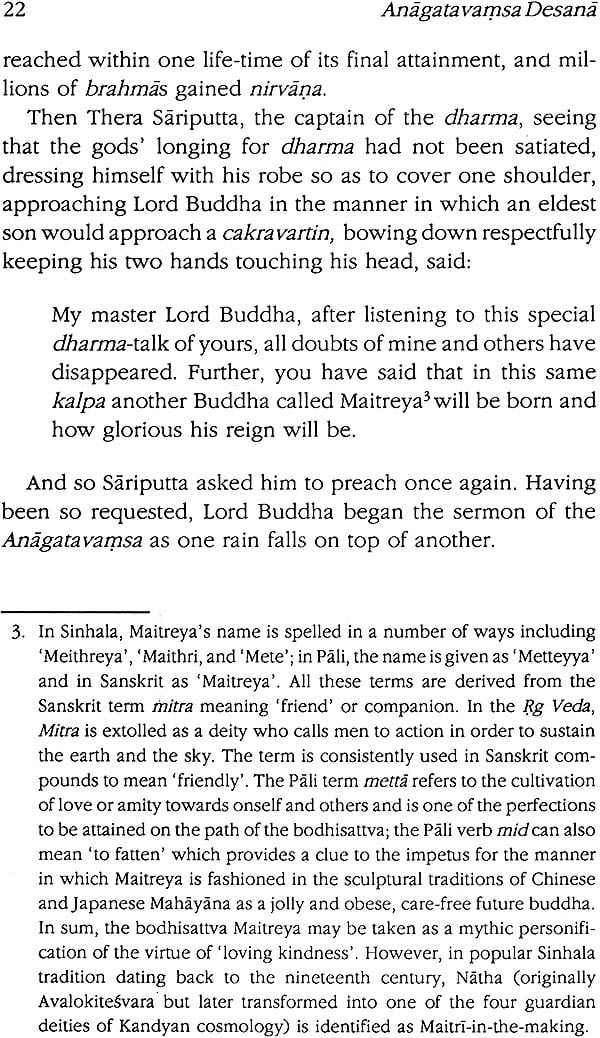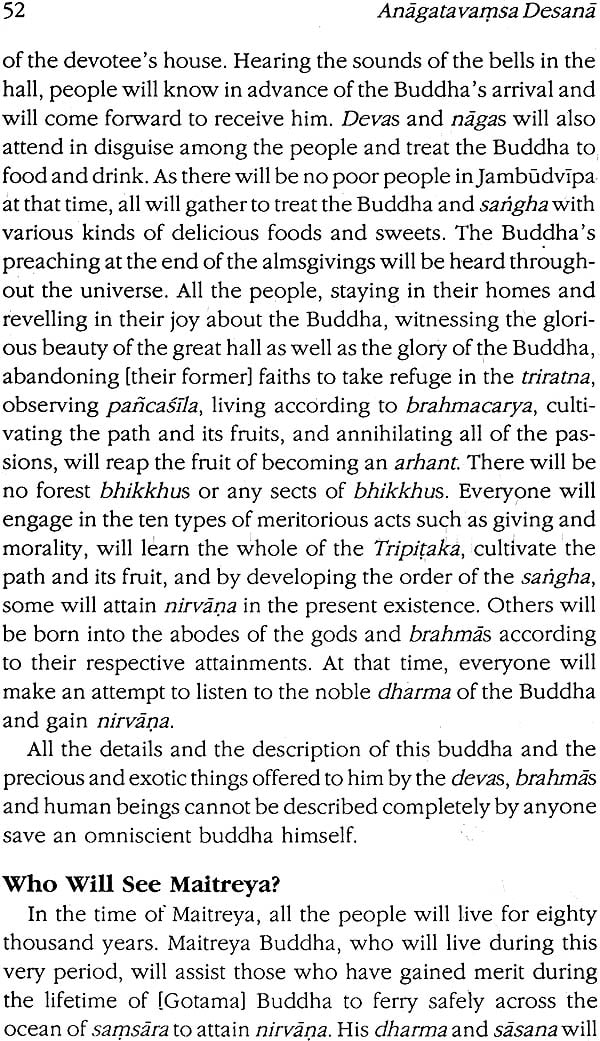
Anagatavamsa Desana the Sermon of the Chronicle-To-Be
Book Specification
| Item Code: | IDC071 |
| Author: | Udaya Meddegama, Edited with an introduction, glossary and notes by John Clifford Holt |
| Publisher: | Motilal Banarsidass Publishers Pvt. Ltd |
| Language: | English |
| Edition: | 2010 |
| ISBN: | 9788120811331 |
| Pages: | 70 |
| Cover: | Hardcover |
| Other Details | 8.8" X 5.5" |
| Weight | 250 gm |
Book Description
From the Jacket
This Sinhala recension of the Anagatavamsa, here translated into English for the first time, is but one of several texts forming a genre of Buddhist apocalyptic literature generated by the cult of Maitreya in South and Southeast Asia. It is a prophetic text revealing a rich religious imagination focused upon the advent of the future Buddha in a time when those who have long persevered in the religious quest will gain an opportunity to realize the highest spiritual attainment.
Udaya Meddegama is Associate Professor in the Department of Sinhalese at the University of Peradeniya in Sri Lanka. He graduated with a B.A. (First Class with gold Medal) from the University of Ceylon and with a Ph.D. from the University of London School of Oriental and African Studies. He has been a visiting professor of South Asian Studies in the USA at Swarthmore, Bowdoin and Hobart and William Smith Colleges. He is the author of many studies focused on Sinhalese literature and has published two anthologies of poetry. He is currently writing a novel based upon his many and varied experiences as a Theravada Buddhist bhikkhu.
John Clifford Holt is Professor of Religion at Bowdoin College in Brunswick, Maine, USA. His recent book, Buddha in the Crown: Avalokitesvara in the Buddhist Traditions of Sri Lanka, was awarded the 1992 American Academy of Religion Award for Excellence in the Study of Religion. He is also the author of Discipline: The Canonical Buddhism of the Vinayapitaka, also by Motilal Banarsidass.
Foreword
The series editor has elsewhere pointed out that after Gautama Buddha's Parinirvana, he continued as a presence in the absence, while the other two 'Jewels' (The Dharma and Sangha) continued in the presence. The Mahasanghika sect was mainly responsible for the popular symbolic formations to fill in this presence in the absence, thus promoting the Jewel of the Buddha. One preeminent solution to this presence in the absence was the cult of the future Buddha, Maitreya, that was even accepted in the Theravada by the Pali name Metteyya.
The Maitreya cult has occasioned rather considerable scholarly study, and the fine text of 'references' give by john Holt does not exhaust the Western Studies since it takes no account of the French Studies.
It is a pleasure to include in the Buddhist Traditions Series this English translation from the Sinhalese of the Anagatavamsa which is a Theravada version for the prophecy of the future Buddha, Maitreya.
Preface
It is our hope that colleagues working in the fields of history of religions, Buddhism and South Asian studies will find this publication helpful in their research and teaching enterprise. While not a canonical text per se, the Anagatavamsa Desana is a paradigmatic example of apocalypticism and eschatology at work in the popular religious imagination.
In transliterating and editing this work from the original Sinhala, Sanskrit and Pali, we have followed the conventions of C. Carter's Sinhala-English Dictionary, Monier Monier-Williams' A Sanskrit-English Dictionary, and T.W. Rhys Davids' and William Stede's The Pali Text Society's Pali English Dictionary.
We are especially grateful to Professor P.B. Meegaskumbura of the Department of Sinhala at the University of Peradeniya, Sri Lanka and to Dr. Sunil Goonasekera of the Institute of Fundamental Studies in Kandy, Sri Lanka, for their very helpful and valuable contributions and insights. WE also acknowledge the support of the National Endowment of the Humanities in Washington, D.C., U.S.A., and Bowdoin College, Brunswick, Maine, U.S.A.
Regarding Professor Wayman's comment in the "Foreword", we are unaware of any significant French scholarship on the Anagatavamsa Desana. Our list of references was not intended as a comprehensive bibliography for "Maitreya Studies". It is only a list of works cited in the "Introduction."
Throughout the historical development of Buddhist traditions in Asian cultures and societies, veneration of the bodhisattva Maitreya (Pali: Metteyya, Sinhala: Maitri; Tibetan: Byama-pa; Chinese: Mi-lo; and Japanese: Miroku) has consistently reflected eschatological visions of an ultimate spiritual salvation and, to a lesser extent, recurrent millennial dreams of collective redemption from the problematic conditions of this-worldly existence. Abiding in the splendid heavenly abode of Tusita in the upper strata of the Buddhist hierarchical cosmos, Maitreya is believed to be the future Buddha whose appearance in the human abode later in this world-cycle (kalpa) will re-establish dharmic norms of righteousness and provide the virtuous with an auspicious time and place to gain the final fruition of the spiritual path: nirvana. Maitreya is thus a mythic figure symbolizing the consummate spiritual future for all Buddhists. Literally, his name means ‘the friendly one.’ The term maître when used in Buddhist philosophical or religious discourse, is usually taken to mean ‘loving kindness’, or the cultivated feeling of well-being about oneself that can be extended to all living creatures. The figure of Maitreya, therefore, embodies the spiritual hope that righteous human beings may some day live in universal concord [Abegg: 30]. As such, this belief in the coming of a future Buddha has been rightly regarded as soteriologically analogous to Judeo-Christian apocalyptic messianism, Islamic expectations of the Mahdi’s return, or the re-appearance of founding culture-heroes in more traditional or ‘primitive’ societies. Visions of Maitreya’s wondrous future age are part of the history of religions in which religieux have expressed a yearning to live amidst temporal conditions supernally conducive to the attainment of the spiritual summum bonum.
Historically, the cult of Maitreya has been truly pan-Asian in scope. References to his bodhisattva are as ancient as the Digha Nikaya of the Pali canon and most scholars concede that his cult had penetrated the ritual life of all South Asian Buddhist communities by at least the beginning of the Christian Era. It is possible that the origins of his cult were influenced by the diffusion throughout ancient northern India of Zoroastrian soteriological beliefs concerning Saosyant, the victorious cosmic savior figure expected to lead the forces of goodness and light to triumph over the forces of evil and darkness at the end of time [Basham: 274]. More specifically, it may be that this Iranian influence took root and was then articulated in the idea of a future Buddha originally amongst Hinayana Buddhist Kashmiri communities several centuries following the demise of the historical Gautama Buddha [Zurcher, I: 391]. Or, it may be that the emergent belief in a future buddha owes its origins to antecedent Jain traditions regarding the continuing lineage of tirthankaras (‘ford-makers’: spiritual ‘victors’ exemplifying the way leading to ultimate spiritual realization), rather than to Persian Zoroastrian sources. In any case, by the time that the Lokottaravada branch of the Mahasanghikas formulated their canonical Mahavastu (the earliest text in which bodhisattvas are conceived of as supernatural beings) Maitreya is found at the head of a list of prophesied future buddhas. Whether or not the impetus for belief in Maitreya is ultimately Persian (Zoroastrian) or Indian (Jain) in origin,
The cult of Maitreya cannot be dated earlier than three centuries after the Buddha’s nirvana, and seemed to have reached its greatest influence in the period from the second to the eighth centuries A.D., the peak occurring about the fifth century. [Kloppenborh: 37]
Whatever the original historical genesis of the cult of Maitreya, Joseph Kitagawa has made the salient point that
One of the most fascinating features of Maitreya is that wherever Buddhism was transplanted his figure evoked ‘potential modes of creativeness’... in the peoples’ religious apprehension and expression. [110]
In contrast to the more formal canons of the Theravada Buddhist tradition where the cult of Mahayana sutras, such as the Saddharmapundarika (Lotus of the True Law) and the Vajracchedika (Diamond Sutra) afford Maitreya a very prominent salvific role along with bodhisattvas Avalokitesvara, Manjusri and Amitabha. To be reborn in the age of Maitreya was regarded as an especially auspicious penultimate spiritual fate. In India, it is likely that visions of Maitreya’s future age contributed significantly to the emerging belief in Amitabha’s paradise, Sukhavati (the ‘Pure Land’), which, when transplanted to China and Japan, eventually became the cornerstone of the most widespread sectarian Buddhist tradition appealing to the laity of East Asia.
| Foreword | vii |
| Preface | xi |
| Introduction | 1 |
| Translation of the Anagatavamsa Desana | 19 |
| Glossary | 57 |
| Index | 69 |









